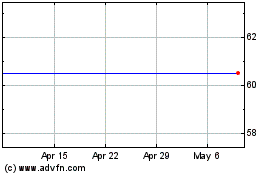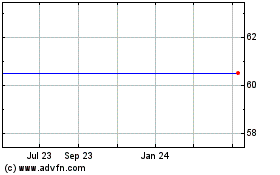Unilever Flags Tough Conditions as Revenue Declines -- 3rd Update
January 26 2017 - 2:57PM
Dow Jones News
By Saabira Chaudhuri
LONDON -- Unilever PLC reported slower sales growth for last
year, spooking investors and underscoring the cost-cutting pressure
that consumer-goods companies face as they struggle to sell more of
their staples, from soap to packaged food, around the world.
Unilever, the world's second-largest consumer-goods firm by
sales after Procter & Gamble Co., is hoping to squeeze about
EUR1 billion ($1 billion) in savings out of costs by next year in
an effort to boost margins and stay profitable. It reported a 5.5%
increase in net profit for 2016 over the year earlier, to EUR5.5
billion.
But the maker of Hellmann's mayonnaise and Ben & Jerry's ice
cream, hasn't been able to lift sales growth, a key metric. Revenue
dropped 1% on the year, hit by unfavorable currency changes.
So-called underlying sales growth, which strips out foreign
exchange and acquisitions, slowed to 3.7% from 4.1% in 2015.
Unilever shares closed 5% lower on Thursday in London.
Consumer-goods firms are struggling with a host of headwinds
they have little control over: fluctuating exchange rates, rising
commodity prices that often feed into packaging or ingredient costs
and tepid global economic growth that has weighed on sales. All
that has triggered a sharper focus on the few things executives can
still influence: costs and nimbleness meeting fast-changing
consumer tastes.
So far, results have been mixed. At P&G, years of
cost-cutting only recently have started to bear fruit. Last week,
the maker of Gillette razors and Pampers diapers posted
better-than-expected organic growth -- which strips out foreign
exchange and acquisitions -- in its latest quarter, and it raised
its fiscal-year growth projection.
Kimberly-Clark Corp., which makes Kleenex and Huggies, recently
completed a cost-cutting plan aimed at saving $140 million
annually. But it said earlier this week it still forecasts tepid
sales growth for 2017.
Last year, Unilever started its own radical cost-cutting effort.
It adopted so-called zero-based budgeting -- a cost-management
practice based on justifying all costs from scratch each year.
The savings is funding an organizational reshuffle aimed at
boosting sales that Chief Financial Officer Graeme Pitkethly told
investors was "the biggest change Unilever has undergone in the
last 10 years." It is restructuring its workforce to direct more
resources to local markets, and giving product-category focused
teams there more autonomy.
That, Unilever hopes, will makes them more nimble to respond to
local tastes or trends. In an interview, Mr. Pitkethly said
Unilever's U.K.-based personal-care team, for instance, now have
the autonomy to change the size and packaging of some Unilever
products so they stay profitable with a price tag of GBP1, or about
$1.26, for British discount retailers like Poundland.
Meanwhile, Unilever continues to struggle to boost sales.
Emerging markets, which make up the bulk of Unilever sales, grew
6.5% down from 7.1% in 2015. Overall volumes fell 0.4% in the
fourth quarter, from the year-earlier period. It was the second
negative-growth quarter in a row. Sales were hit in particular by
Brazil's economic crisis and India's demonetization program. For
the year, volumes edged up 0.9% from 2015.
Write to Saabira Chaudhuri at saabira.chaudhuri@wsj.com
(END) Dow Jones Newswires
January 26, 2017 14:42 ET (19:42 GMT)
Copyright (c) 2017 Dow Jones & Company, Inc.
Unilever NV (NYSE:UN)
Historical Stock Chart
From Mar 2024 to Apr 2024

Unilever NV (NYSE:UN)
Historical Stock Chart
From Apr 2023 to Apr 2024
